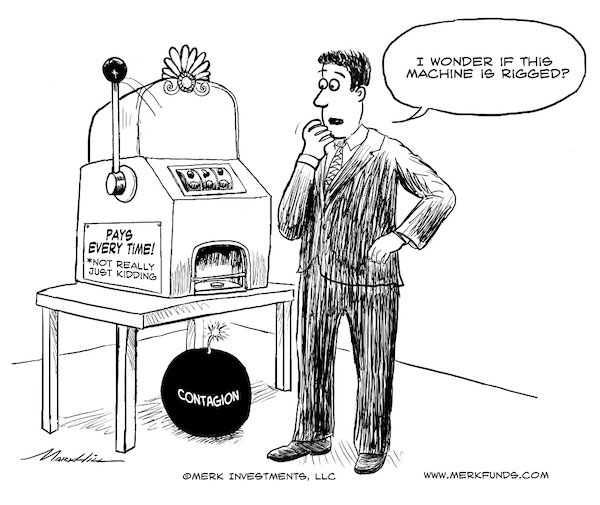“Don’t panic, buy the dip, who cares?” or “These are rumblings of an earthquake, people will be hurt like in 1929” – which one is it? I would call it a wake-up call. Let me explain:

In recent years, markets had appeared eerily “safe”. Central banks promised to do “whatever it takes”, provided “forward guidance” to keep rates low, even printed money to buy government debt, calling it “quantitative easing.” Sure enough, volatility has been low, valuations have risen. Now, just as the fellow from the cartoon above, many might have thought something isn’t quite right. As a result, many investors have been looking to buy some insurance, protection, just in case this goldilocks environment doesn’t last forever. For those who have looked for ways to protect against a decline, they likely noticed that it had been rather expensive. Indeed, we had come to the conclusion some time ago that it may be more prudent for many investors to hold more cash rather than hold risk assets on the one hand, but then, say, buy put options in addition. However, cash in a 0% interest rate environment is not sexy (and holding cash a recipe for professional investors to lose client assets), causing many investors to have come up with ever more creative ways to “diversify.” We put diversify in quotes because many investors may be fooling themselves: many of those alternatives are reaching for yield and may well be risk assets in disguise, meaning they may be similarly vulnerable in a risk off environment.
One way to buy “protection” is to buy derivatives or exchange traded products that rise when volatility rises. The most direct way is to buy futures on the volatility index VIX; retail investors bought an exchange traded note that invested in such contracts; note that the underlying derivatives periodically (monthly) expire, so there is a continuous rebalancing between the nearest contract and those further out. Anyone who has bet on a rise in volatility through these instruments knows that you continuously lose money, unless you get the timing right. That is, it costs you at times over 10% a month for the right to potentially benefit when volatility rises. I say “potentially” because it isn’t even assured you make money when you get the timing right because it isn’t enough for volatility to rise at any particular moment; to make money with these instruments, volatility needs to rise in the forward markets, i.e. the market has to price in higher volatility several weeks from now when the underlying derivative matures. Confused yet? I allege that many that have purchased these instruments do not fully understand them.
The hottest trade on Wall Street last year was to be “on the other side” of the fearful, that is to speculate volatility will remain low. Speculators could reap, and many did, over 10% a month, over 100% a year. What could possibly go wrong? Notably, the argument was that even if there was a surge in volatility, it would almost certainly be short-lived. So just as those buying protection were frustrated that the pricing of volatility in forward months didn’t move much, those selling volatility benefited from this stickiness. So what if you lose some money temporarily, you can surely take home riches over time?! Sure enough, ever more speculators followed the call of the sirens, piled into this must win trade. Except, of course, this wasn’t a must win trade. Instead, it was a disaster in the making. On February 5, in a 24-hour period, some exchange traded products lost over 90% in value. You make 100% in one year, then lose 90% in a day; for those that need a refresher how percentages work: if you start with $100, you temporarily have $200, but end up with $20, i.e. you lose 80%. Not. A. Good. Deal.









Leave A Comment